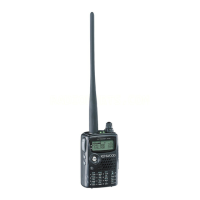5 OPERATING THROUGH REPEATERS
14
REVERSE FUNCTION
The reverse function exchanges a separate receive
and transmit frequency. So, while using a repeater,
you can manually check the strength of a signal that
you receive directly from the other station. If the
station’s signal is strong, both stations should move
to a simplex frequency and free up the repeater.
To swap the transmit and receive frequencies:
Press [REV] to switch the Reverse function ON (or
OFF).
• “R” appears when the function is ON.
Note: You can turn the Reverse function ON when you are
operating in Simplex mode. However, it does not change the TX/
RX frequency.
AUTOMATIC SIMPLEX CHECK (ASC)
While using a repeater, the ASC function periodically
checks the strength of a signal that you are receiving
directly from the other station. If the station’s signal is
strong enough to allow direct contact without a
repeater, “ ” indicator on the display starts blinking.
Press [REV] (1 s) to switch the function ON.
•“ ” appears when the function is ON.
•While direct contact is possible, “ ” blinks.
•To quit the function, press [REV].
Note:
◆ Pressing the PTT switch causes “ ” icon to quit blinking.
◆ ASC can be activated while operating in Simplex mode.
However, it does not change the TX/ RX frequencies.
◆ ASC does not function while scanning.
◆ Activating ASC while using Reverse switches Reverse OFF.
◆ If you recall a memory channel or the Call channel that
contains a Reverse ON status, ASC is switched OFF.
◆ ASC causes received audio to be momentarily intermitted
every 3 seconds.
◆ ASC does not function when the band is not selected for
operation.
TONE FREQ. ID SCAN
This function scans through all tone frequencies to
identify the incoming tone frequency on a received
signal. You may use the function to find which tone
frequency is required by accessing your local
repeater.
1 While the Tone function is ON, press [F],
[TONE] (1 s) to start the Tone Freq. ID scan.
•When the transceiver receives the signal, the
scan starts.
•To reverse the scan direction, turn the Tuning
control or press [ ]/ [ ].
•To quit the function, press [PTT] or [ ].
• When the tone frequency is identified, a beep
sounds and the identified frequency appears.
2 Press [ ] to program the identified frequency in
place of the current tone frequency.
• Press [ ] if you do not want to program the
identified frequency.
• Press [ ]/ [ ] while the identified frequency is
blinking, to resume scanning.
Note: Some repeaters do not re-transmit the access tone in the
downlink signal. In this case, check the other station’s uplink
signal to detect the repeater access tone.
144.725 MHz
145.325 MHz
144.725 MHz
TX: 144.725 MHz TX: 144.725 MHz TX: 144.725 MHz TX: 145.325 MHz
RX: 145.325 MHz RX: 145.325 MHz RX: 145.325 MHz RX: 144.725 MHz

